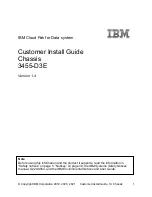
1-70
Cisco ASA Series CLI Configuration Guide
Chapter 1 Configuring Connection Profiles, Group Policies, and Users
Group Policies
lost, and the backup servers have different DNS and WINS information, clients cannot be updated until
the DHCP lease expires. In addition, if you use hostnames and the DNS server is unavailable, significant
delays can occur.
To configure backup servers, enter the
backup-servers
command in group-policy configuration mode:
hostname(config-group-policy)#
backup-servers
{
server1 server2... server10
|
clear-client-config
|
keep-client-config
}
To remove a backup server, enter the
no
form of this command with the backup server specified. To
remove the backup-servers attribute from the running configuration and enable inheritance of a value for
backup-servers from another group policy, enter the
no
form of this command without arguments.
hostname(config-group-policy)#
no backup-servers
[server1 server2... server10 |
clear-client-config
|
keep-client-config
]
The
clear-client-config
keyword specifies that the client uses no backup servers. The ASA pushes a null
server list.
The
keep-client-config
keyword specifies that the ASA sends no backup server information to the client.
The client uses its own backup server list, if configured. This is the default.
The
server1 server 2.... server10
parameter list is a space-delimited, priority-ordered list of servers for
the VPN client to use when the primary ASA is unavailable. This list identifies servers by IP address or
hostname. The list can be 500 characters long, and it can contain up to10 entries.
The following example shows how to configure backup servers with IP addresses 10.10.10.1 and
192.168.10.14, for the group policy named FirstGroup:
hostname(config)#
group-policy FirstGroup attributes
hostname(config-group-policy)#
backup-servers 10.10.10.1 192.168.10.14
Configuring Network Admission Control Parameters
The group-policy NAC commands in this section all have default values. Unless you have a good reason
for changing them, accept the default values for these parameters.
The ASA uses Extensible Authentication Protocol (EAP) over UDP (EAPoUDP) messaging to validate
the posture of remote hosts. Posture validation involves the checking of a remote host for compliancy
with safety requirements before the assignment of a network access policy. An Access Control Server
must be configured for Network Admission Control before you configure NAC on the security appliance.
The Access Control Server downloads the posture token, an informational text string configurable on the
ACS, to the security appliance to aid in system monitoring, reporting, debugging, and logging. A typical
posture token is Healthy, Checkup, Quarantine, Infected, or Unknown. Following posture validation or
clientless authentication, the ACS downloads the access policy for the session to the security appliance.
To configure Network Admission Control settings for the default group policy or an alternative group
policy, perform the following steps.
Step 1
(Optional) Configure the status query timer period. The security appliance starts the status query timer
after each successful posture validation and status query response. The expiration of this timer triggers
a query for changes in the host posture, referred to as a status query. Enter the number of seconds in the
range 30 through 1800. The default setting is 300.
To specify the interval between each successful posture validation in a Network Admission Control
session and the next query for changes in the host posture, use the
nac-sq-period
command in
group-policy configuration mode:
Summary of Contents for 5505 - ASA Firewall Edition Bundle
Page 28: ...Glossary GL 24 Cisco ASA Series CLI Configuration Guide ...
Page 61: ...P A R T 1 Getting Started with the ASA ...
Page 62: ......
Page 219: ...P A R T 2 Configuring High Availability and Scalability ...
Page 220: ......
Page 403: ...P A R T 2 Configuring Interfaces ...
Page 404: ......
Page 499: ...P A R T 2 Configuring Basic Settings ...
Page 500: ......
Page 533: ...P A R T 2 Configuring Objects and Access Lists ...
Page 534: ......
Page 601: ...P A R T 2 Configuring IP Routing ...
Page 602: ......
Page 745: ...P A R T 2 Configuring Network Address Translation ...
Page 746: ......
Page 845: ...P A R T 2 Configuring AAA Servers and the Local Database ...
Page 846: ......
Page 981: ...P A R T 2 Configuring Access Control ...
Page 982: ......
Page 1061: ...P A R T 2 Configuring Service Policies Using the Modular Policy Framework ...
Page 1062: ......
Page 1093: ...P A R T 2 Configuring Application Inspection ...
Page 1094: ......
Page 1191: ...P A R T 2 Configuring Unified Communications ...
Page 1192: ......
Page 1333: ...P A R T 2 Configuring Connection Settings and QoS ...
Page 1334: ......
Page 1379: ...P A R T 2 Configuring Advanced Network Protection ...
Page 1380: ......
Page 1475: ...P A R T 2 Configuring Modules ...
Page 1476: ......
Page 1549: ...P A R T 2 Configuring VPN ...
Page 1550: ......
Page 1965: ...P A R T 2 Configuring Logging SNMP and Smart Call Home ...
Page 1966: ......
Page 2059: ...P A R T 2 System Administration ...
Page 2060: ......
Page 2098: ...1 8 Cisco ASA Series CLI Configuration Guide Chapter 1 Troubleshooting Viewing the Coredump ...
Page 2099: ...P A R T 2 Reference ...
Page 2100: ......



































